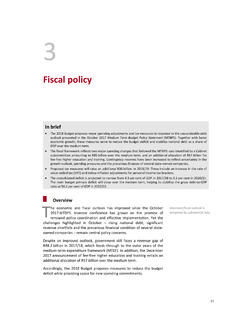Transcription of Division of revenue and spending by provinces and ...
1 75 6 Division of revenue and spending by provinces and municipalities In brief Allocations to provinces and municipalities grow at average annual rates of per cent and per cent respectively over the next three years. provinces and municipalities are enhancing operational efficiency and looking at ways to raise additional own revenue as wages and basic service provision costs escalate. Growth in wage costs has been partially offset by a reduction in the number of provincial employees. Over the period ahead, filling of vacant posts will be subject to approval, and non-essential spending will be curtailed.
2 provinces will receive additional allocations to expand HIV/AIDS prevention and treatment, improve infrastructure spending and support early childhood development. Conditional grant rules have been changed to encourage local government to maintain existing infrastructure and improve planning. An amount of million has been allocated in 2016/17 and 2017/18 for areas affected by the redrawing of municipal boundaries, which will reduce the total number of municipalities from 278 to 257. Overview ver the next three years, the cost to provinces and municipalities of providing public services is expected to grow faster than transfers from national government.
3 Slower growth in transfers is the result of a reprioritisation to fund new spending needs and return budget growth to a sustainable path. At the same time, wages and the cost of bulk services such as water and electricity are expected to grow faster than inflation. In response, provincial and municipal governments are strengthening efforts to work more efficiently, reduce non-core spending and increase funding from own revenue . The Division of revenue between national, provincial and local government takes into account the powers and functions assigned to each level of government, as well as their ability to raise revenue .
4 Provincial governments are responsible for implementing nationally determined policies in education, health, social development, agriculture, roads and human settlements. Local governments are responsible for providing basic Cost of public services growing faster than national government transfers O 2016 BUDGET REVIEW 76 services such as water and sanitation, electricity reticulation, refuse removal, municipal transport and roads, and community services. They also provide free or subsidised basic services to poor households. municipalities fund a significant portion of the costs of providing these services from user charges and property rates within their own tax base.
5 Division of revenue Table summarises the Division of revenue over the medium-term expenditure framework (MTEF). Of the funds available after providing for debt-service costs and the contingency reserve, per cent is allocated to national government, per cent to provincial government and per cent to local government over the next three years. The Division of revenue in Table includes an amount of billion provisionally allocated in 2018/19, but which will only be assigned to specific programmes during the 2017 Budget, subject to the approval of a spending proposal.
6 Of this amount, billion has indicatively been allocated to the provincial equitable share and billion to local government conditional grants. Transfers to provinces and local government are made through the equitable share and conditional grants. The equitable shares are determined by formulas that take into account demographic and developmental factors. Conditional grants are designed to achieve certain goals, and Table Division of nationally raised revenue , 2012/13 2018/192012/132013/142014/152015/162016/ 172017/182018/19R billionOutcome Revised estimate Medium-term estimatesDivision of available fundsNational of which.
7 Indirect transfers to transfers to local fuel levy sharing with allocations 1 1 1 1 1 Debt-service reserve Main budget expenditure 1 1 1 1 1 1 Percentage sharesNational Includes unallocated amountsSource: National TreasuryAverage annual MTEF billion added in 2018/19, to be allocated to specific programmes in 2017 Budget CHAPTER 6.
8 Division OF revenue AND spending BY provinces AND municipalities 77 provinces and municipalities must meet specific criteria to receive grants and fulfil conditions when spending them. Underspending has decreased across national, provincial and local government. In 2014/15, national government expenditure amounted to billion (excluding direct charges) out of a total adjusted appropriation of billion. This represents underspending of per cent. Provincial government underspent its adjusted budget of billion for 2014/15 by billion ( per cent), compared with billion ( per cent) in the previous year.
9 municipalities spent billion ( per cent) of their infrastructure grants in 2014/15, up from per cent in 2013/14. The proportion of conditional grant funding spent also continues to improve. In 2014/15, expenditure on the health facility revitalisation grant increased to per cent from per cent in 2012/13. spending on the provincial roads maintenance grant rose to per cent from per cent over the same period. Provincial operating grants tend to perform more consistently and are spent better than infrastructure grants. spending on both the national school nutrition programme grant and the comprehensive HIV and Aids grant, for example, exceeded 99 per cent in 2014/15.
10 Local government infrastructure grants also improved their performance, with spending on the municipal infrastructure grant increasing from per cent in 2012/13 to per cent in 2014/15. Funds allocated to the integrated national electrification programme grant in 2014/15 were fully spent. The Explanatory Memorandum to the Division of revenue sets out the national, provincial and municipal allocations, details the equitable share formula, and explains how the Division takes into account the recommendations of the Financial and Fiscal Commission.













